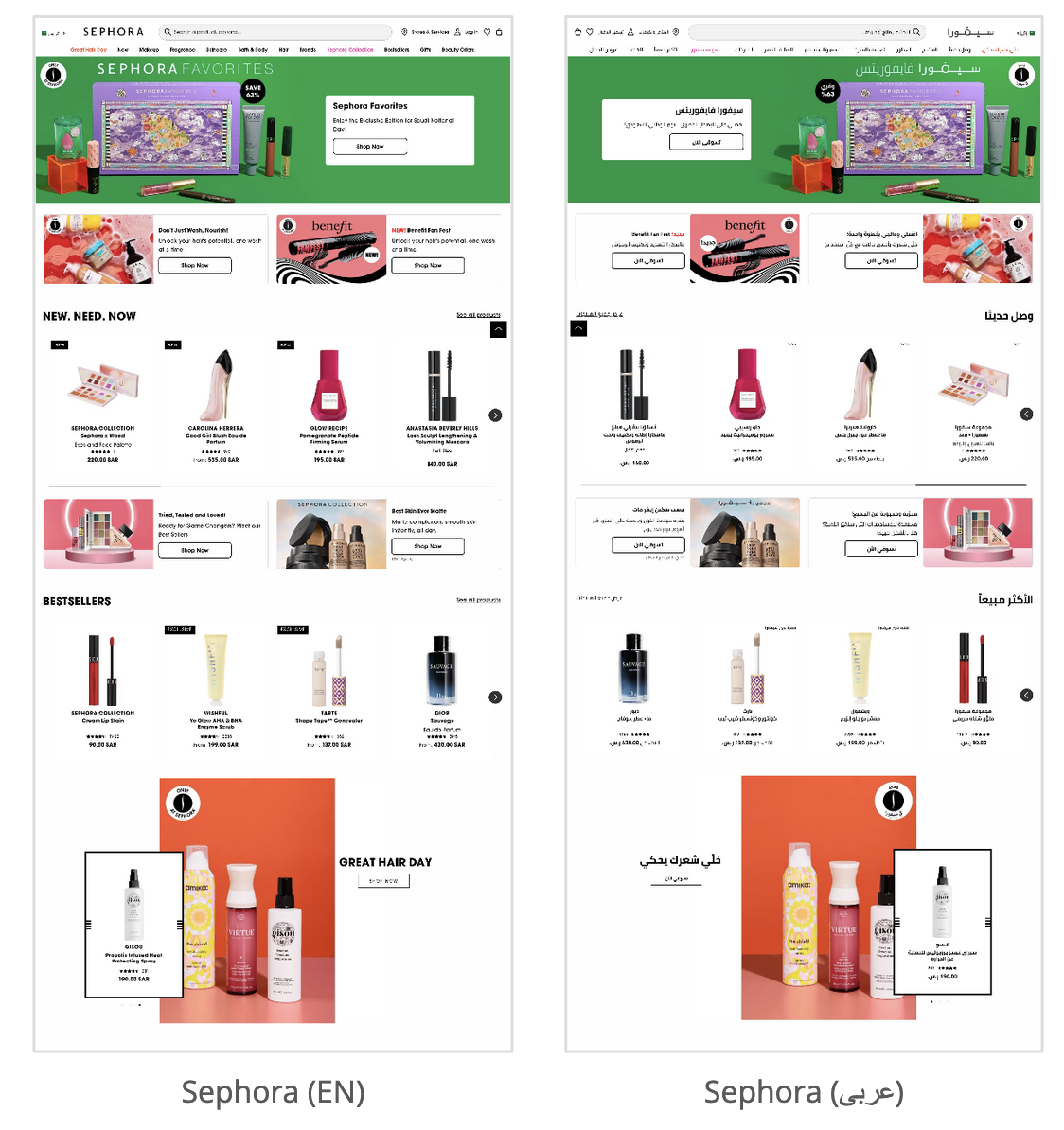December 24, 2023
UX in the Middle East
The Middle East is a region in full digital growth. The population is young, metropolitan and connected. Internet and smartphone usage rates are among the highest in the world.
Provided this context, UX (User Experience) is a key success factor for companies looking to expand in the region. What are the specific interface and user experience expectations of Internet users in the Middle East?
We'll tell you all about it in our webinar on the subject, summarized below. This webinar is currently available in French with English subtitles.
Why adapt your interface to the local region?
Importance of location
Interface localization is crucial to adapting to cultural specificities. In Saudi Arabia and the United Arab Emirates, understanding culture, social norms and user expectations is essential. User experience (UX) can also establish positive and lasting relationships with users.
Ferpection offers a wide range of services, from working hand-in-hand to define UX strategies, to setting up workshops. User Insights are obtained through various methodologies, such as individual interviews and remote testing. The emphasis is also on accessibility, eco-conception and inclusiveness, with the fundamental mission of having a positive impact (UX for Good).
Cultural and social adaptation
Dutch researcher Geert Hofstede has identified six cultural dimensions, including individualism, long-term orientation and indulgence. Comparing France with Saudi Arabia and the United Arab Emirates, significant differences emerge, notably in terms of collectivism, preference for short-term results, and social constraints.
Communication also varies, with different levels of emotional expression and avoidance of confrontation. Understanding these nuances is crucial to UX success.
Digital market trends in the Middle East
Focusing on Saudi Arabia and the United Arab Emirates, we examine the exponential growth of digital in the region. The Arabic language, in particular, has seen a dramatic increase in online content. Internet usage has been boosted by public policies, reducing economic and technological inequalities.
The explosion in social networking, partly due to the "Arab Spring", has boosted online presence. However, there are still disparities in Internet use, particularly when it comes to online payment. Recommendations, such as offering a variety of payment methods, are suggested to address these disparities.
In short, UX in the Middle East requires an attentive approach to local culture, communication, and the rapid evolution of digital. Understanding these elements is the key to creating responsive, inclusive and high-performance interfaces in this fast-growing region.
Socio-cultural norms
Here's an introduction to social and cultural norms in the Middle East, and their impact on the field of user experience (UX).
General background
- The Middle East is a cultural crossroads influenced by Turkish, Persian and Arab cultures.
- Home to the three great monotheistic religions: Islam, Judaism and Christianity.
- Variety of cultural norms, from conservative (Saudi Arabia) to more open (Lebanon).
Representing Arab culture in UX
- Arab culture is under-represented in the professional UX field.
- Bias in studies conducted abroad, often by American researchers, creating a disconnect with Arab culture.
Consequences for user research
- Disconnect between designers and Arab cultural experts.
- Risk of ignoring user needs, leading to frustration and non-use of products.
Manifestation of cultural elements
- Examples from Saudi Arabia: Islamic rules for interfaces (no sale of alcohol, respect for religious holidays).
- Importance of religious holidays for online promotions (Eid, Ramadan).
Impact on digital
- Colors and images: Analysis of e-commerce sites in Saudi Arabia, with specific colors and restrictions on images.
- Importance of providing information on halal food, prayer sites, etc., in travel apps.
Sharing of personal data
- Major user concerns linked to conservative standards and distrust of public administrations and commercial companies.
Evolution of UX culture in the region
- The UX approach is relatively new in the region.
- Difficulties recruiting users and adopting Western concepts.
UX initiatives and community
- Growth of UX culture in Dubai, Zayed University, Riyadh.
- Creation of the "Arab HCI" community to promote UX research and facilitate collaboration.
User test and results
- Difficulties in using the Gregorian calendar, need to give priority to the Islamic calendar.
- Importance of taking into account linguistic duality (English-Arabic) in interfaces.
- Enhancement of local brands, credibility of opinions by local residents.
Creating interfaces in the Middle East
Here are a few concrete aspects of interface creation in the Middle East, based on the socio-cultural elements mentioned above.
Language and bilingualism
- Importance of offering several languages on websites, mainly English or Arabic.
- Examples of interfaces with the option of changing the language using flags.
Search and navigation
- Need for double entry in form fields and navigation bars to facilitate searches in different languages.
Reading direction
- Adapting the interface to the right-to-left reading direction.
- Examples of sites with reverse navigation.
Things to consider
- Number management: use of Arabic numerals and adaptation of selection and reading.
- Icons: some reverse, some don't. Observe reality to guide choices.
- Emojis: importance of adapting emojis to local culture.
- Typography: take into account the specificities of Arabic to ensure legibility.
Adapting the Interface
- Impact on screen space due to the specificities of Arabic.
- Play with calligraphy to maintain brand identity.
- Be careful to maintain legibility despite adaptations.
Conclusion
While digital practices are flourishing in the Middle East, the opportunities they represent cannot be imagined without solid user research, the only way to capture local subtleties while keeping pace with a rapidly evolving landscape.
If you enjoyed this introduction to UX in the Middle East, you'll probably enjoy our article on international UX research.
Ferpection carries out half of its projects in 2 or more countries. Don't hesitate to tell us about yours!
All articles from the category: User research | RSS

